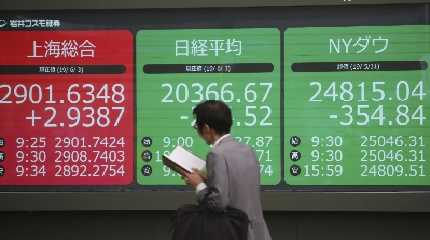
TOKYO (AP) — Asian benchmarks were mostly lower on Friday, echoing a decline on Wall Street, after a quarterly report by Japan’s central bank rekindled worries about the world’s third largest economy.
Recent data suggest global growth is slowing as countries grapple with renewed waves of coronavirus outbreaks, soaring prices and the war in Ukraine.
Shares fell in Japan and South Korea, but rose slightly in Australia. Trading was closed in Hong Kong for a holiday.
In the Bank of Japan “tankan” survey, the headline index for large manufacturers was 9, down from 14 in the previous quarter and the second straight quarter of declines. The tankan measures corporate sentiment by subtracting the number of companies saying business conditions are negative from those responding they are positive.
The numbers for non-manufacturing indicators were better, but worries are growing because of pressures from a weakening Japanese yen.
The tankan results might spur criticism over the Bank of Japan’s ultra-loose monetary policy, which is a factor behind the weaker yen, said Stephen Innes, managing partner at SPI Asset Management.
“The Bank may wait until the Q3 survey is released before stepping away from its ultra-dovish setting,” he said in a report.
However in a bit of positive news, a survey by a Chinese business magazine, Caixin, found China’s factory activity expanded in June at its strongest rate in 13 months following an easing of anti-virus restrictions that shut down Shanghai and other industrial centers..
A monthly purchasing managers’ index issued by Caixin rose to 51.7 from 48.1 in May on a 100-point scale on which numbers above 50 show activity increasing. New orders rose while employment declined for a third month.
Japan’s benchmark Nikkei 225 dropped 0.8% to 26,175.78. Australia’s S&P/ASX 200 edged up 0.2% to 6,580.90. South Korea’s Kospi lost 0.4% to 2,322.55. The Shanghai Composite rose 0.2% to 3,403.85.
Hong Kong’s markets were closed for a holiday.
On Thursday, Wall Street closed out its worst quarter since the onset of the pandemic in early 2020. It was the worst first half since the first six months of 1970.
“And in 1970 there was a solid rebound after that first half decline,” said Lindsey Bell, chief markets and money strategist at Ally Invest. “This time around, the impact of the Fed, the impact of inflation and the uncertainty of where growth goes from here is really weighing on investors’ minds. ... We just don’t know when the clouds of uncertainty are going to start to clear.”
The S&P 500 fell 0.9%, its fourth consecutive drop, to 3,785.38. The benchmark index is now down 21% since it hit an all-time high at the beginning of the year. It entered a bear market earlier in June.
The Dow Jones Industrial Average fell 0.8%, to 30,775.43. The Nasdaq slid 1.3% to 11,028.74, and small company stocks also fell, with the Russell 2000 losing 0.7% to 1,707.99.
Rising inflation has been behind much of the slump for the broader market this year as businesses raise prices on everything from food to clothing and consumers are squeezed tighter. Inflation remains stubbornly hot, according to a series of recent economic updates.
The Federal Reserve and other central banks have been aggressively raising interest rates to try and slow economic growth in order to cool inflation. Higher rates can bring down inflation, but they also risk a recession by slowing the economy too much. They also push down on prices for stocks, bonds, cryptocurrencies and other investments.
The yield on the 10-year Treasury, which helps set mortgage rates, fell to 3.01% from 3.09% late Wednesday.
Technology companies were among the biggest weights on the market, as investors continued to favor utilities and other traditional defensive stocks. Apple fell 1.8%, while Exelon rose 2.2%.
Retailers and other companies that rely directly on consumer spending also posted big losses. Amazon slipped 2.5% and Best Buy shed 2.9%.
Investors got another update on inflation Thursday. A measure of inflation that is closely tracked by the Fed rose 6.3% in May from a year earlier, unchanged from its level in April. The report from the Commerce Department also said consumer spending rose at a sluggish 0.2% rate from April to May.
The update follows a worrisome report earlier this week showing that consumer confidence slipped to its lowest level in 16 months. The government has also reported that the U.S. economy shrank 1.6% in the first quarter. Weak consumer spending was a key part of that contraction.
The OPEC oil cartel and allied producing nations decided Thursday to increase production of crude oil, but the amount will likely do little to relieve high gasoline prices at the pump and energy-fueled inflation plaguing the global economy.
In energy trading, benchmark U.S. crude added 50 cents to $106.26 a barrel in electronic trading on the New York Mercantile Exchange. Brent crude, the international standard, added 63 cents to $109.66 a barrel.
In currency trading, the U.S. dollar inched down to 135.28 Japanese yen from 135.75 yen. The euro cost $1.0464, down from $1.0484.




